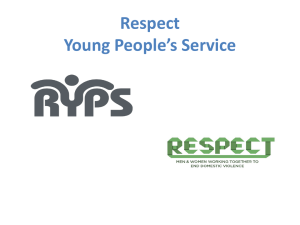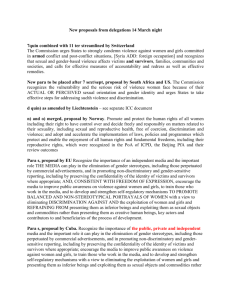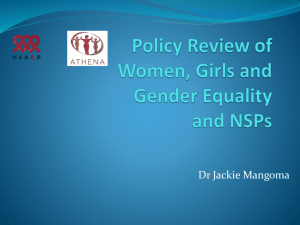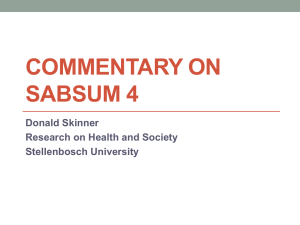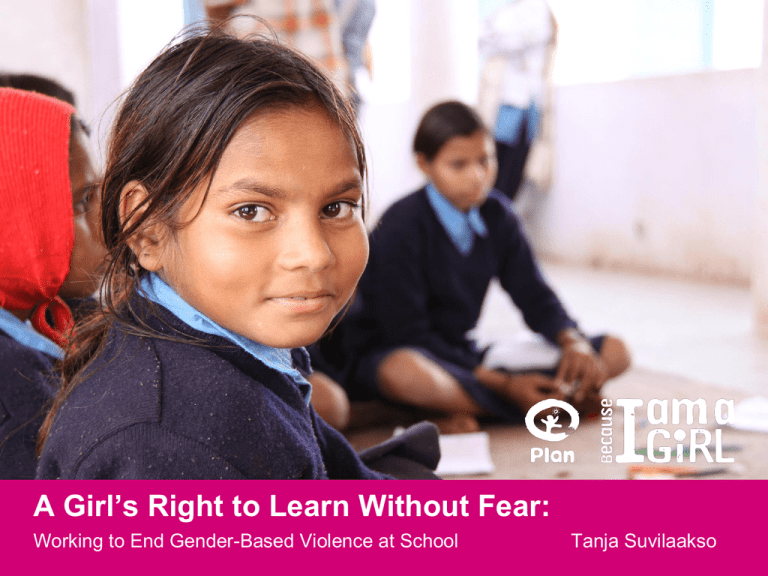
A Girl’s Right to Learn Without Fear:
Working to End Gender-Based Violence at School
Tanja Suvilaakso
A Girl’s Right to Learn Without Fear:
Working to End Gender-Based Violence at School
Because I am a Girl campaign is focused on
eliminating some of the key barriers to girl’s
education: child marriage and the persistence of
gender-based violence in and around schools.
A Girl’s Right to Learn Without Fear:
Working to End Gender-Based Violence at School
Plan Canada and University of Toronto, Faculty of
Law- International Human Rights Program
8 key global principles
Examples of promising practices from countries
internationally recognized
School related gender-based violence
defined
SRGBV refers to:
•
Sexual, physical or psychological violence
•
Inflicted on children in and around schools
•
Due to stereotypes and roles or norms attributed to or
expected of them on the basis of their sex or gendered
identity.
SRGBV also refers to the ways in which experiences of and
vulnerabilities to violence may be gendered.
Inside and outside of school
• Latrines, empty classrooms and corridors are all potential
spaces where violence can occur.
• Millions of girls and boys are at risk of bullying, rape,
unwanted touching, and unprovoked sexual advances in
transit to and from school, along walking routes, at bus
stops, and at taxi stands.
• Isolation and lack of sufficient oversight and management
can exacerbate the problem.
Conflict: Girls and boys even more at
risk of GBV in and around schools
• One child in three in conflict-affected countries does not go
to school, compared to one in 11 in other low-income
countries.
• In many conflict-affected areas, school children are more
likely to be subject to violent attacks.
• The use of sexual violence as a weapon of war has been
widespread, and many victims are young girls.
Prevalence
• Worldwide, an estimated
150 million girls and 73
million boys have
experienced sexual
violence.
• In some countries, more
than 80% of students
suffer corporal punishment
at school.
• In Mozambique, for example, a
government study found that 70% of
girl respondents reported knowing
that some teachers used sexual
intercourse as a condition for
promotion between grades.
• In Niger, a study showed that 88% of
teachers confirmed existence of
sexual acts between students and
teachers at their school.
Prevalence continued
“Moyennes Sexuellement Transmissible STM” (Gabon, Cameroon)
“Chalk allowance” of “Bush stipend”
“Le menace du bic rouge” (Mali)
“Droit de cuissage” (Côte d’Ivoire)
Forms of SRGBV
Sexual violence
Bullying in schools
Cyber-bullying
Physical and psychological violence as
‘discipline’
Causes
•Harmful social, cultural, and religious norms
•Discrimination and social marginalisation
•Missing legal safeguards and weak
institutional capacity
Consequences
Immediate and long-term:
•Health consequences (STDs, HIV infection,
unwanted early pregnancies)
•Psychological suffering
•Poor performance at school, absenteeism
and high drop out rates
•Reduced economic opportunities
Time for Solutions
• Teachers have and can be engaged as critical
allies
• Schools can act as catalysts for non-violence,
tolerance, and gender equality
• Attitudes and behaviours can be transformed
• Facilities can be reformed
• Programmes and policies can be strengthened
Eight principles for government action
1.
Comprehensive and integrated action
2.
Effective legislation and regulation
3.
Safe and effective reporting and response
4.
Evidence-based policy
5.
Well-supported, well-trained personnel
6.
Partnership
7.
Inclusiveness
8.
Participation
Link to the report
The Canadian edition of the report is
available at:
http://plancanada.ca/publications





